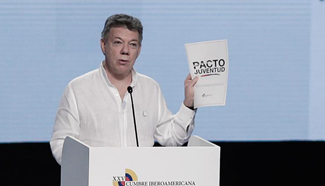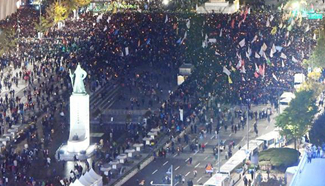by Chris Dalby
MEXICO CITY, Oct. 29 (Xinhua) -- Some might say that a Hollywood blockbuster influencing a millennial celebration is tawdry. However, the opening scene of a James Bond film, Specter, where the British super-spy chases a villain through a massive parade, complete with giant skulls and costumed dancers, became so iconic that the city decided to recreate it for real.
This year, Mexico City revamped its Day of the Dead celebrations, declared by the United Nations Educational, Scientific and Cultural Organization (UNESCO) to be part of the Oral and Intangible Heritage of Humanity in 2003. On Saturday afternoon, the biggest Day of the Dead parade in the history of the city danced, thrilled and spooked its way through the streets, from the iconic Angel of Independence to the central Zocalo square.
Floats topped by giant, grinning skulls, worrisome Aztec warriors painted black, corpse brides, skeletons on roller blades, Christian crossed covered in marigolds, the various visions of the dead delighted the thousands of people lining on the way.
The parade was divided into three separate stages. The first, named the journey to Mictlan, the name of the Aztec underworld, showed representations of pre-Hispanic gods from the Mexica, Mixteca and Zapoteca cultures, and was overseen by the Aztec god of Death, Mictlantecuhtli.
The second part, the Child of Death, recalled elements of a tradition seen in the colonial era of the 19th century when the remains of deceased children were adorned in rich clothes for the celebration of the Holy Innocents. These were first displayed on paintings before being woven on cloth but some snapshots of this macabre ritual remain from the early days of photography.
The third and final segment looked at the celebration of the dead from a modern perspective, namely a party that honors death and the afterlife. The floats reflected the collective imagination of the Mexican people and recalled the works of Jose Guadalupe Posada, a printmaker who first created the Catrina -- an image depicting a female skeleton dressed only in a hat befitting the upper class outfit of a European time. Frida Kahlo, Mexico's most famous cultural ambassador today, was also honored.
Around 1,000 participants accompanied the process, dressed in various costumes, symbolizing the worship of death and its celebration in Mexico from pre-Hispanic times to the present. Most recognizably, the Catrina, for many the face of the celebration, was frequently seen in the form of an elegantly dressed woman with the face of a skull.
Along the route, vendors were blending tradition with delectation, offering calaveritas, colorful sugar skulls, or the typical pan de muerto (bread of the dead).
The parade ended after two hours at the Zocalo square, where a giant offering to the dead has been built, named "Ode to Water", designed by visual artist Betsabee Romero.
Following the parade, a nighttime ride is to take place from the park of Chapultepec, in the heart of Mexico City, to the Zocalo. The only condition for participation: to be dressed up in disguise for the occasion, of course.
The celebration does not stop on Saturday night, however. Over the next three days, families will gather at the altars they have built at their homes. Orange marigolds, hailed as the flowers of the dead, have been sprinkled across the alter, accompanied by fruit and other food favored by the deceased when they were alive. According to local tradition, these offerings help their spirits to remember their former lives.
For those brave enough to face the witching hour and head outside the home, concerts and artistic activities will be held across the city.
Far from the vision of death certain other cultures may hold, Mexican see it as part of the natural cycle of life, a moment not to be feared but embraced. The deceased are never forgotten but honored every year, forging a connection with future generations.










